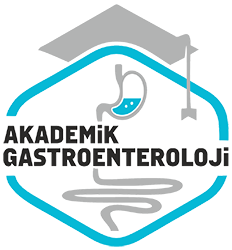İrritabl barsak sendromu olan hastalarda anormal safra kesesi motilitesi
Abnormal gallbladder motility in patients with irritable bowel syndrome
Başkent Üniversitesi Tıp Fakültesi, Gastroenteroloji Bilim Dalı3, Ankara
Özet
Giriş ve amaç: İrritabl barsak sendromlu (İBS) hastalarda özellikle safra kesesi (SK) düz kaslarının uzun süreli kontraksiyona uğradığı düşünülmektedir. İBS’li hastalarda safra kesesi fonksiyonlarını ultrasonografik olarak değerlendirmeyi amaçladık. Gereç ve yöntem: Roma II kriterlerine göre İBS tanısı alan 6 erkek, 14 kadın toplam 20 hasta (yaş ortalaması: 38±3 yıl) ile 16 kadın 6 erkek sağlıklı 22 kişi (yaş ortalaması: 41±3 yıl) çalışmaya alındı. Tüm olguların safra kesesi, intra ve ekstrahepatik safra yolları 8 saatlik açlık dönemi sonrası ve ayrıca oral olarak 100 gr çikolata verildikten sonra ultrasonografi ile değerlendirildi. Bu incelemede 4 parametre incelendi: 1) açlık safra kesesi volümü, 2) iki saat sonraki rezidüel volüm, 3) üç saat sonraki rezidüel volüm ve 4) maksimum kontraksiyondan sonraki rezidüel volüm. Ayrıca pre ve postprandiyal, açlık ve yeme sonrası rezidüel volümlerden safra kesesi ejeksiyon fraksiyonları hesaplandı. Bulgular: İBS’li hastalarda ve kontrol grubunda sırası ile; açlık SK volümü 19.64±3.09 ml ve 20.04±1.82, iki saat sonraki rezidüel volüm 9.54±1.75 ml ve 12.22±1.93 ml, üç saat sonraki rezidüel volüm 3.36±6.82 ml ve 9.74±1.50 ml, maksimum kontraksiyondan sonraki rezidüel volüm 16.28±3.28 ml ve 10.29±1.35 ml, safra kesesi ejeksiyon fraksiyonu %55.4±5.8 ve %52.7±5.3 idi. Sadece üçüncü saatte alınan SK volümlerinde İBS’li hasta grubunda kontrol grubuna göre istatistiksel olarak anlamlı derecede bir düşüş izlendi (p<0.001). Sonuç: Bizim çalışmamız postprandiyal 2. saatte safra kesesi kontraksiyonunda İBS’li ve sağlıklı kontrol grubu arasında anlamlı fark olmadığı- nı ancak 3. saatin sonunda İBS’li olgularda daha fazla kontrakte olduğunu gösterdi. Bu bulgular İBS’li olgularda safra kesesi fonksiyonlarının da etkilenebileceğini düşündürmektedir.
Abstract
Background/aim: It has been considered that patients with irritable bowel syndrome (IBS) may have long contraction period in the smooth muscles, particularly of the gallbladder. The aim of this study was to evaluate gallbladder function in IBS patients. Materials and methods: Twenty patients (6 male, 14 female; mean age 38 ± 3 years) diagnosed as IBS based on Roma II criteria and 22 healthy controls (6 male, 16 female; mean age 41 ± 3 years) were enrolled in the study. In all patients and healthy controls, gallbladder and bile ducts were evaluated with ultrasonography following an 8-hour fasting period and after a fatty meal (100g chocolate). Four parameters were investigated: 1) fasting gallbladder volume, 2) postprandial residual volume at the end of 2 hours, 3) postprandial residual volume at the end of 3 hours, and 4) residual volume after maximal contraction. In addition, ejection fraction of the gallbladder was calculated from the fasting and postprandial volumes. Results: In IBS patients and healthy controls, fasting gallbladder volumes were 19.64 ± 3.09 ml and 20.04 ± 1.82 ml; residual volumes after 2 h were 9.54 ± 1.75 ml and 12.22 ± 1.93 ml; residual volumes after 3 h were 3.36 ± 6.82 ml and 9.74 ± 1.50 ml; residual volumes after maximal contraction were 16.28 ± 3.28 ml and 10.29 ± 1.35 ml; and ejection fractions of the gallbladder were 55.4% ± 5.8 and 52.7% ± 5.3, respectively. Residual volume after 3 h was significantly less in the IBS patients than in the controls statistically (p<0.001). Conclusion: Our study showed that gallbladder contraction in patients with IBS was not different from the control group at the postprandial 2nd hour, but was significantly more pronounced at the end of 3 hours when compared with controls. This finding may be a contributing factor that infuences gallbladder function.



